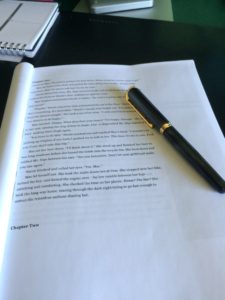 This month’s blog post covers the first part of the revision and editing process after you have completed your rough draft I wrote about last month. If you missed that post, here is the link for it: https://blog.writingwhiledistracted.com/?p=2289
This month’s blog post covers the first part of the revision and editing process after you have completed your rough draft I wrote about last month. If you missed that post, here is the link for it: https://blog.writingwhiledistracted.com/?p=2289
Revisions and editing are what I consider the fun part of writing. You are about to take your wobbly messy first draft and shape it into something that resembles a novel. For a lot of people who struggle with distraction issues and executive function, crafting the structure of our novels is one of the most difficult parts of writing, because every scene has to have a beginning, a middle, and an end in order to tell a coherent story.
Our brains don’t always work that way. Our brains are really good a filling in the blanks in our stories in our minds but those thoughts do not always make it to the page.
It is often what makes many people with distraction issues struggle with basic editing. Either we read fast and skip over what is not there, or we get distracted during reading and miss that our story is incoherent. In order to meet story telling conventions and create a novel that has a clear beginning, middle, and an ending that makes sense we need a simple way to look at our story overall, a helicopter view of our novel.
The best way I have found to do this is objectively to create a reverse outline from your manuscript. In creating a reverse outline, you work from your manuscript as it is and create a list of scenes in each chapter. As with anything you are outlining you can make it as brief as detailed as you like. The minimal things that need to be in the outline for each scene are
- The setting, where does the scene take place?
- Who is in the scene?
- What point of view is the scent told from?
- What is the point of the scene? What occurs to move the story forward, or show character?
Ideally a scene will both move the story forward and show the reader character development.
Here is an example: Exterior of a burned building. Fire inspector Mel is conducting an interview with a businessman who doesn’t want to talk to her and is acting rude/weird/anxious. Mel ignores his rudeness and is kind. The man relaxes and reveals he upset because he is afraid he will be exposed as having an affair as his car has been blocked in by the fire equipment and he will be very late getting home.
When you are finished with the outline, read back through it. It will become clear if you have left things out, or if you have scenes that don’t move the story along or show character development. If a scene does not meet those requirements, no matter how much you love it the scene needs to go or to be incorporated into another scene. Wherever possible have a scene do both things, it will really tighten up your writing.
The point of a reverse outline is you should be able to read through it and understand a short coherent version of your story. A reverse outline will also demonstrate if your chapter lengths are correct for the pacing of the story. If you have one chapter that is sixteen scenes long and the other chapters that are one scene long, you might need to configure those chapters to even out the pacing of the story. Think of a chapter as break in the story for your readers to consider what has already occurred and what might happen next. There is nothing wrong with a one scene chapter if it fits the novel. If it is a very long scene or if it’s a pivotal scene and you want to set it apart, you can decide where you want your scenes in your book. Sometimes if my story is very broken I will take my reverse outline and transfer it to 3×5 cards.
It is not my normal practice but if my structure majorly flawed, I need a strong visual to be able to sort it I will. Folks with distraction issues and other mental health issues that affect our executive functions often struggle with organization. Our brains may organize something in a way that makes no sense to anybody else, but it makes sense to us. The problem with this is if you’re writing a story you hope will be read and understood by more people than just you, you need to take the time to make sure your story makes sense. It is the very first step in organizing a rough draft.
The two parts of story structure you want to look at are plot, the things that happen in your story, and character arcs, the changes your character undergoes because of the things that happen in the story. As much as you want to make sure the plot of your story makes sense you want make sure you show your character’s development because your character should change over the course of the story. Even your character does not change their behavior, showing they had the chance to change and turned away from it can be just as compelling. The mantra of writers is show don’t tell and that can be the hardest thing for new writers to grasp. Sandra Gerth, aka Jae has a fantastic book about showing versus telling in writing and I recommend it if you are struggling to understand how to do it. https://www.amazon.com/Show-Dont-Tell-descriptions-characters-ebook/dp/B01LXFJ0AC/
Your characters journey should have a beginning, a middle, and an end. Some people may argue that if you’re a genre fiction writer and you’re writing the same character over again, for example if you have a detective series or some kind of thriller series or any kind of series where you are working with the same set of characters and they have different adventures over the course of the series it’s not necessary.
I would submit having your character change, even in small ways over the course of your series is going to make your books much more entertaining and much more readable. As much as we appreciate characters who are always the same as there is some comfort in familiar and knowing a character, as a reader you can’t wait to see how they will behave in a new story, in a new setting, and with a new challenge, submit stories that bring the same character, but have them change over the course of the series are infinitely more readable and addicting.
That’s my opinion, your mileage may vary, but if you have an opportunity to have your characters change over the course of story do it.
If you’re writing standalone books, character arcs are the heart of your story so making sure you have appropriate scenes to show the development of the character, and their internal and external struggles is a vital part of story structure and compelling story telling.
I wrote about prewriting here: https://blog.writingwhiledistracted.com/?p=2274 and how important it is to build a solid foundation for your story. If you unsure about how your character would behave in a scene, go back to your prewriting and your character worksheets and compare them with your reverse outline. Has your character changed? At what cost?
Make sure you have scenes that demonstrate what they have to sacrifice to attain their goals. Sacrifice is what drives story whether it’s an internal such as giving up or modifying their self-image, or an external sacrifice, such as forgoing monetary rewards by not developing land down by the marsh the character had planned to build luxury condos on that their love interest is working hard to protect as a nature preserve for waterfowl.
Character growth and development draws readers in. This the point in the revision process where you fix any issues and tweak the scenes to demonstrate those changes and plot points that are key to understanding your story. This is when you fix all the broken issues in your story so take your time here, especially if like me you work from a loose outline and write a discovery draft, if you’re a pantser and don’t work from any outline, you need to make sure you have developed the story and character arcs in a way that makes sense and your characters stay in character.
Nothings worse than reading a book and all of a sudden there’s some wacky change in a character. If you’re like me you raise an eyebrow and say, sometimes say out loud, “What the heck? Why would she do that?” Sometimes several chapters later some bit of character history comes to light that explains why the characters behavior, but in the worst case the reader is left wondering, ‘did I miss something?” which does not lead to an enjoyable reading experience. It can lead to folks not finishing the story because as an author have lost them by your character behaving out of character without explanation.
This your opportunity to correct any major issues with your novel, because if you have to fix problems later, when you get your copy edits back from your editor, or your beta reader, and they have commented “What the heck? Why did she do this?” It’s going to take a lot more work at that point in the book writing process versus taking the time to restructure and add in scenes to make you characters behavior and your story make sense.
Another tool that you can use for examining your structure is to listen to your book. There are ways that you can have Microsoft Word and other Word processing programs read your work back to you. If you’re someone who has with audio processing or needs a different method of work for whatever reason listen to your story and make notes of what needs to be corrected in your scenes.
I usually listen to my work, either reading it out loud or having my word processor read my story to me when I’m working on dialogue, but there is no reason why you can’t use the same process to reverse outline your story. Use whatever method works for you.
Many neurospicy folks become overwhelmed and disheartened when they begin the revision process. They remember the struggle it was to complete the manuscript, look at all the work they have done, and can’t imagine doing more. Take the same approach to revising a novel as you did when writing it.
Be consistent, about the time you spend, focus on one project until you get it done, and don’t quit. When you run across those things that don’t make sense, where you’ve got things out of order or jumbled don’t be discouraged, make notes and then act.
For folks with distraction issues and people with poor executive function, this will be the hardest part of the writing process. Organizing our thoughts and our words in a correct and orderly fashion is excruciating at times. The best thing you can do for yourself is take your time, work in short bits of time, and be kind to yourself.
Take the time to create a reverse outline, it will make your efforts so much easier because you will have your story laid out in front of you, you will know where you’re going with the story, why you wrote the scenes you did. If you question why you had your character behave in a certain way, go back and read your pre-writing, read your character worksheets, look at whatever notes you made about your characters until you figure it out.
This will work for both character driven stories and a plot driven stories. Even plot driven stories are still about character because we read to connect with other ideas, and other people. We imagine ourselves in a different world. We read to discover how characters are going to handle whatever situations they face in the book.
It is entertaining, it keeps readers turning pages even in a plot driven story where you are trying to defeat the big bad, or find the bomb before it goes off, the characters who are trying to find the bomb are still people. They’re going to have things happen to them and they’re going to change over the course of trying to find the bomb before it goes off and you should keep this in mind while working on your novel structure.
If you are writing genre fiction this is the time to make sure you are meeting genre expectations. If you are writing a mystery make sure you have clues scattered in your novel so your readers can solve the crime with your detective, or if you are writing a thriller that you are maintaining tension throughout the story. If you are writing romance be sure your scenes convince your reader The couple in your story belong together no matter what.
So, if you are at the starting line with revising and editing your novel, overwhelmed and freaking out, or if you have been revising and feel stuck, please try creating a reverse outline by hand or listen to your draft and take notes paying attention to structure and character development. Once your structure is nailed down, you can go back and do what I call the window dressing, which is where you work on word choice, description, and dialog. That will be the subject of a future of a future blog post until then keep writing.






